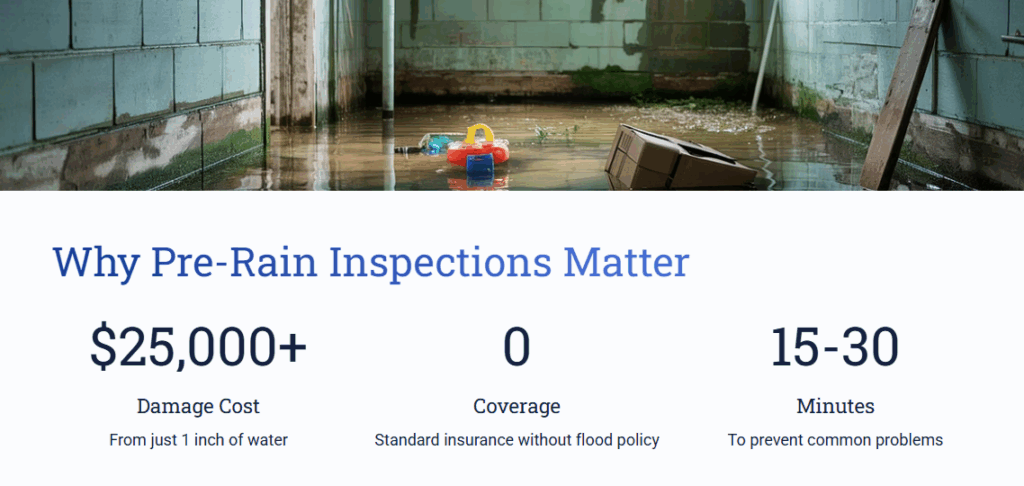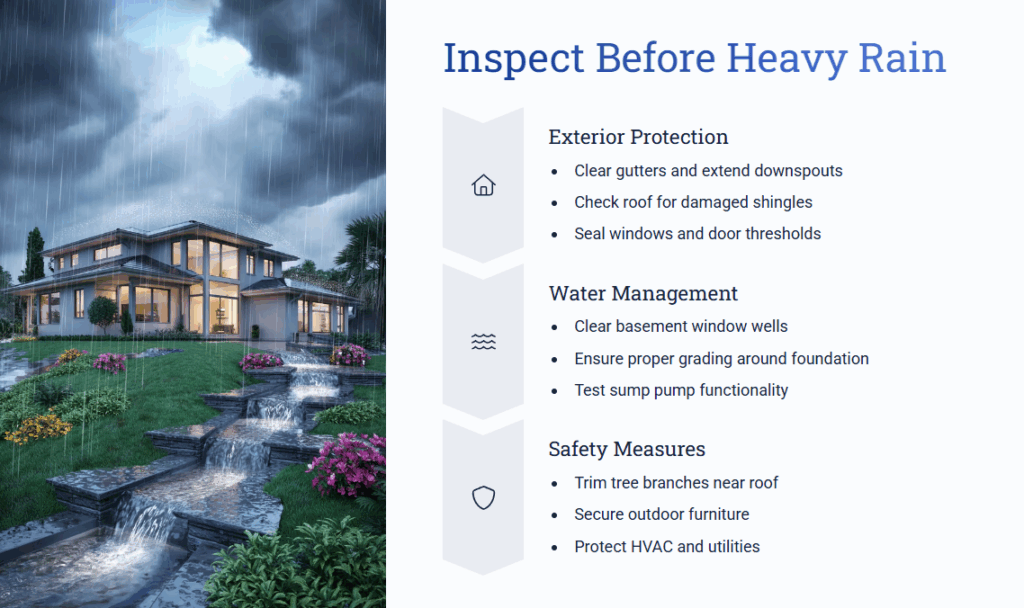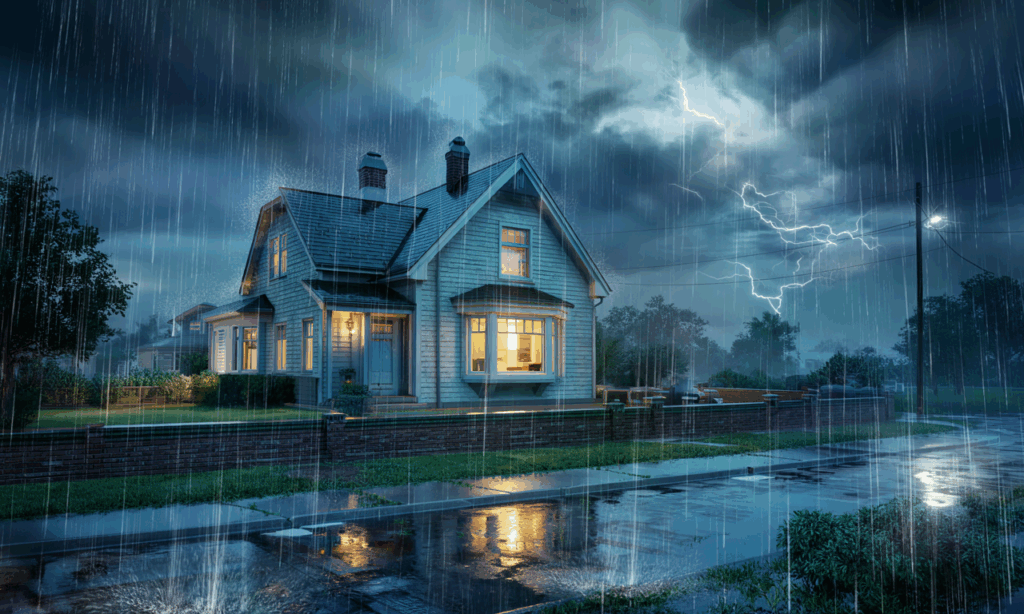When heavy rain is in the forecast, most homeowners think about grabbing an umbrella—but what about protecting your home? A few simple checks around your property can prevent thousands of dollars in water damage, electrical issues, or even health risks from mold.
This guide walks you through exactly what to check before a storm hits—with clear explanations, real-world examples of what happens when things go wrong, and a free downloadable checklist you can use each season.
Why Pre-Rain Inspections Matter
- According to FEMA, just 1 inch of water in your home can cause $25,000+ in damage[1].
- Most homeowner insurance policies do not cover flood damage unless you have separate flood insurance.
- Many common problems—like clogged gutters or cracked foundation seals—are preventable with 15–30 minutes of effort.
Let’s walk through what to check, why it matters, and how to do it efficiently.

Homeowner’s Checklist: 15 Things to Inspect Before Heavy Rain
1. Gutters & Downspouts
- Why it matters: Clogged gutters overflow and pour water directly down your walls or into your foundation.
- What to do: Clear debris, ensure downspouts extend at least 4 feet away from your home.
2. Roof Condition
- Why it matters: Missing or damaged shingles let water in and damage insulation, ceilings, or even electrical systems.
- What to do: Use binoculars or a drone to spot cracked shingles or flashing gaps. Hire a roofer if unsure.
3. Window Seals & Frames
- Why it matters: Water seeps through worn-out caulking and rots window sills or causes mold.
- What to do: Check for peeling caulk or drafts; reseal with exterior-grade silicone.
4. Exterior Doors & Thresholds
- What happens if ignored: Rainwater puddles at doorways, warps flooring, or seeps into subfloors.
- What to do: Ensure weather stripping is tight and intact.
5. Basement Window Wells
- Why it matters: Overflowing wells are one of the top causes of basement flooding.
- What to do: Clear leaves, install plastic covers if exposed.
6. Grading Around Foundation
- Why it matters: Water should slope away from your home, not toward it.
- What to do: Add soil if the ground is sloping inward. Avoid mulch against siding.
7. Sump Pump Functionality
- Why it matters: A failed sump pump can cause a flood in minutes.
- What to do: Test it manually and install a battery backup if you don’t already have one.
8. Backflow Valve or Sewer Check
- What happens if ignored: A sewer backup during heavy rain can destroy your home’s lowest level.
- What to do: Have a plumber inspect or install a backwater valve.
9. Tree Branches Near Roof
- Why it matters: Branches can damage roofing or clog gutters mid-storm.
- What to do: Trim back any limbs hanging within 6 feet of the house.
10. Outdoor Drains and Driveway Slopes
- What happens if ignored: Driveway drains overflow, pushing water into garages or basements.
- What to do: Clear grates, sweep debris from channels.
11. Patio Furniture & Yard Items
- Why it matters: High winds can turn these into flying hazards.
- What to do: Store lightweight items inside or anchor them securely.
12. Detached Structures (Sheds, Greenhouses)
- Why it matters: Roof leaks or unstable doors can cause flooding or flying debris.
- What to do: Check doors, anchor the roof, and store tools off the ground.
13. Garage Door Seals
- Why it matters: Garages often flood due to inadequate bottom seals.
- What to do: Replace worn weather stripping and consider a garage floor drain.
14. HVAC & Utility Exposure
- What happens if ignored: Electrical boxes or HVAC units near ground level can short out.
- What to do: Cover exposed units and seal conduit entries with weatherproof foam.
15. Emergency Supplies & Documents
- Why it matters: If something goes wrong, you’ll want quick access to flashlights, first aid, and insurance info.
- What to do: Store essentials in a waterproof container.

For a broader storm preparation guide, including emergency kits and evacuation tips, check out Ready.gov’s official checklist.
🔗 Ready.gov Severe Weather Prep
Downloadable: Printable Rainstorm Prep Checklist (PDF)
Perfect for taping inside your utility room or sharing with neighbors!
FAQs – People Also Ask
Q1. How do I check my gutters before rain?
Use a ladder to look for leaves, nests, or standing water. Flush with a hose to test drainage.
Q2. Should I turn off power before a storm?
If flooding is imminent, yes—shutting off power at the breaker may prevent electrocution.
Q3. Can heavy rain damage my foundation?
Absolutely. Repeated saturation causes shifting, cracks, or basement leaks—especially if grading or drainage is poor.
Q4. What’s the best way to seal basement windows?
Use window well covers, clean drains, and apply waterproof caulk around seams.
Don’t wait for bad weather to protect your home. Our Ultimate Home Maintenance Checklist: Seasonal and Monthly Guide helps you stay ahead of problems with proactive care every month of the year.
Final Thoughts
Preparing for rain doesn’t have to be overwhelming. With this checklist in hand, you can tackle the most important tasks in an hour or two—and avoid costly damage down the line.
🌧️ “It’s not the storm itself that hurts—it’s what you didn’t prepare for.”
Reference

